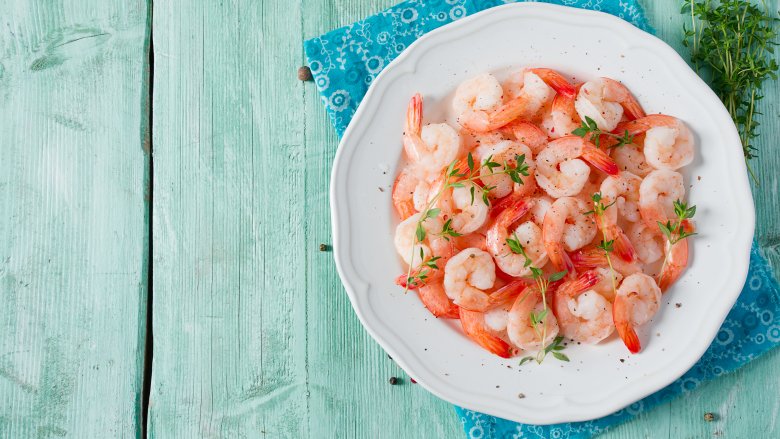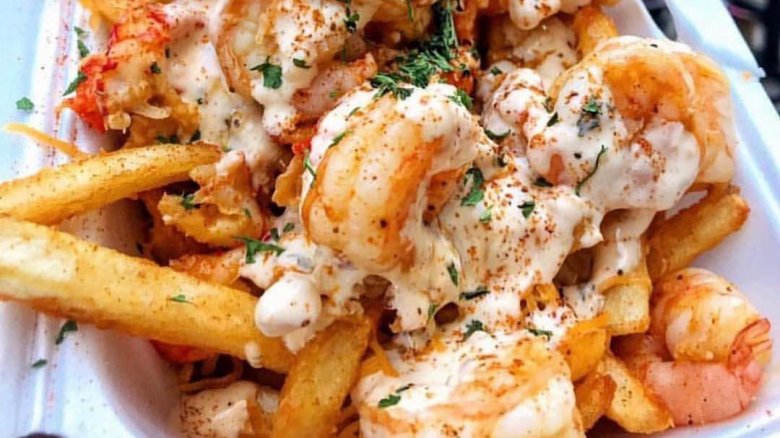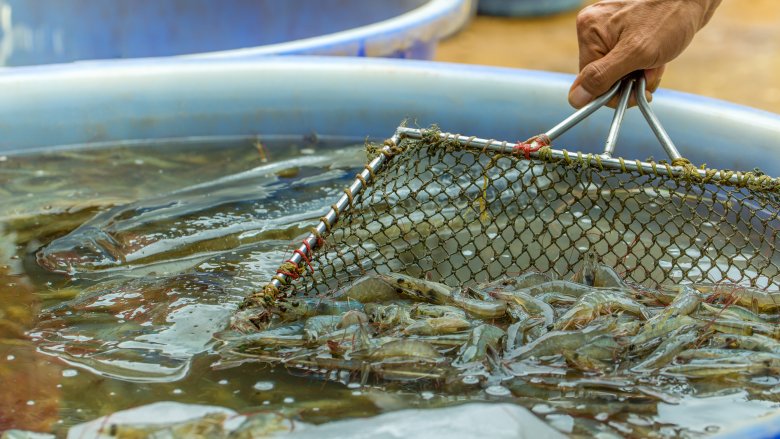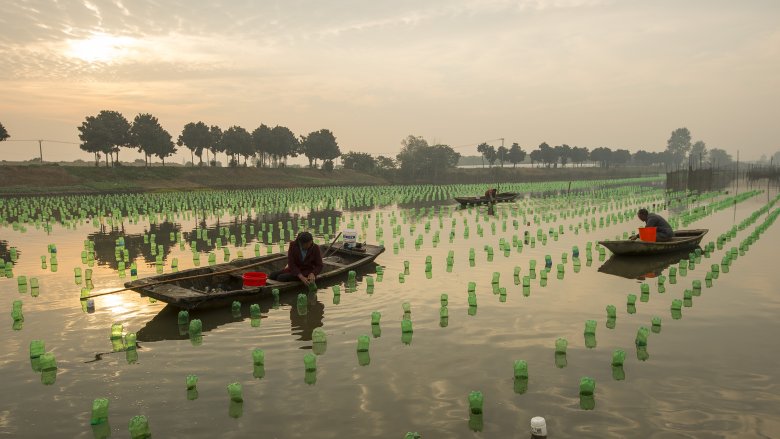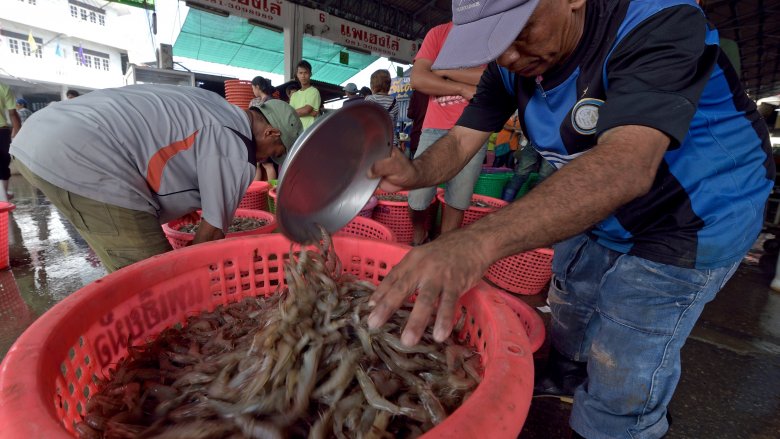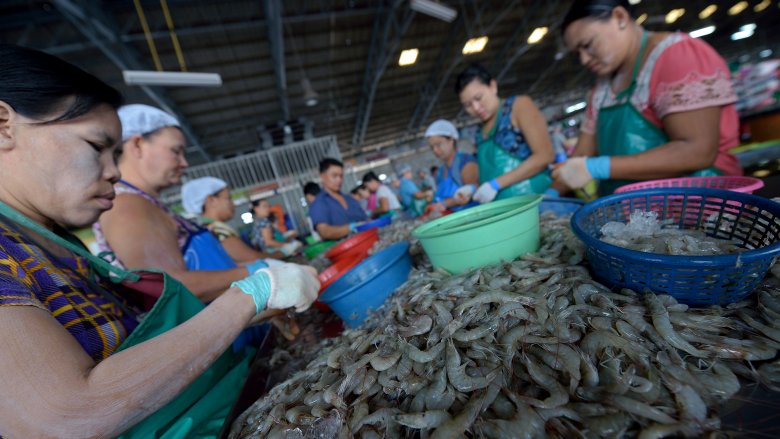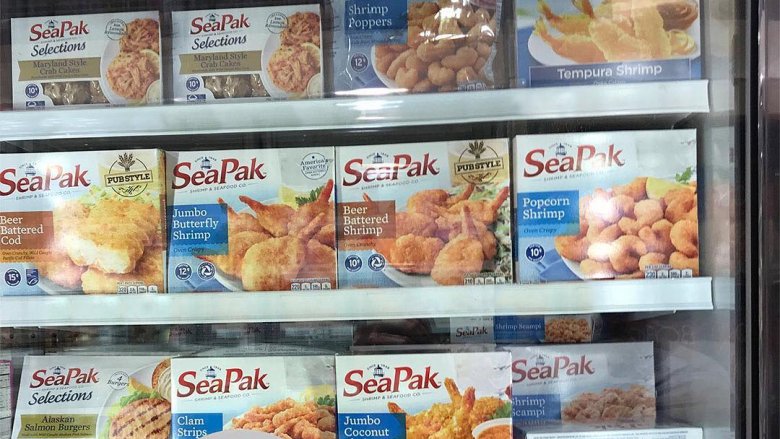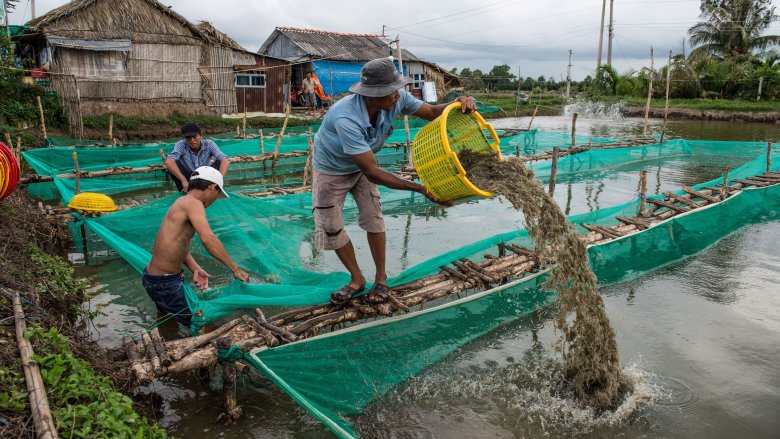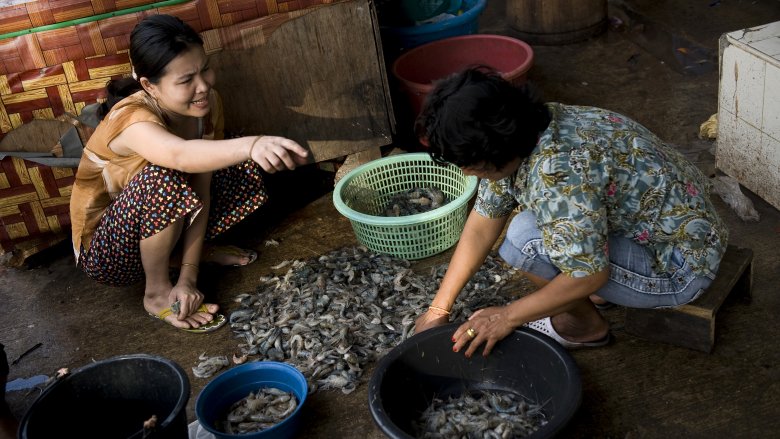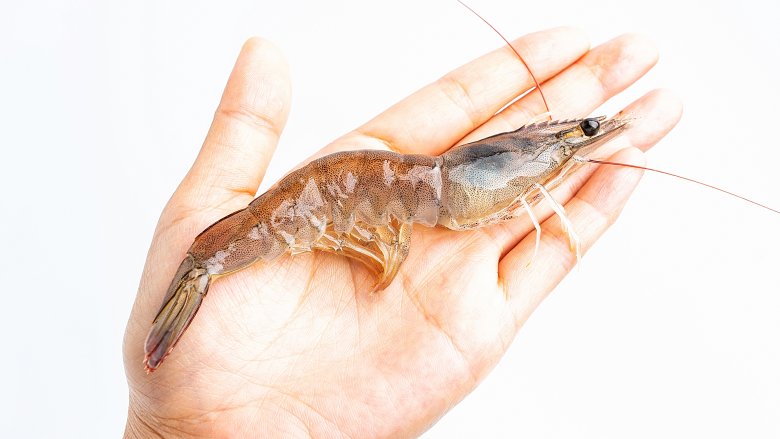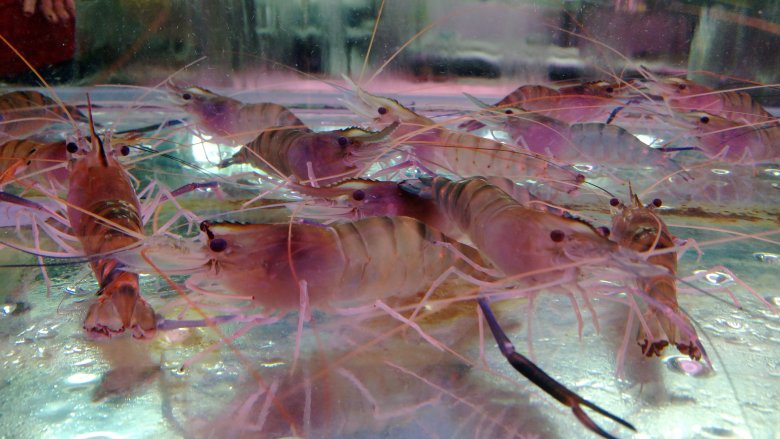What You Need To Know Before You Eat Another Bite Of Shrimp
Did you ever stop to wonder how we all got so shrimp-crazed in the United States? After all, the curvy crustacean is the most widely consumed seafood in the country, with an annual consumption level of 4.4 pounds per person. But who was the first person to decide to break the head and tail off of a shrimp, scrape out its pooper, boil it, peel off its shell, and dip the chilled, butchered carcass into ketchup and horseradish?
Shrimp's rise to prominence in the American diet may have begun in an unlikely way, as a kind of tongue-in-cheek sneer at American Prohibition in the 1920s. With the ban on alcohol in full swing, lonely bartenders and restaurateurs were left with nothing to do but gaze at all of those empty martini glasses, which were no longer filled with delicious, ice-cold gin. Instead, entrepreneurs began serving a "shrimp cocktail," lining the unused vessels with boiled shrimp and a spicy sauce made with ketchup, lemon juice, and hot sauce. Long after the amendment banning alcohol sales was repealed, our national fascination with the kitschy dish endured.
It's not all fun and games for shrimp eaters, however. A devotion to eating shrimp comes with more than a few downsides, from health-related problems, to environmental concerns, to human rights violations. Let's take a look at what you need to know before you take another bite.
They're crazy-high in cholesterol
You may not think much about the dietary implications of shrimp, even as you're mowing through a pound-and-a-half of peel-and-eat. After all, nothing that small could possibly be bad for you, right?
While shrimp are naturally super low in calories, with a medium shrimp containing just seven measly calories, you can eat a dozen while adding only 84 calories to your total daily intake. In fact, you're probably consuming almost as many calories with the cocktail sauce you're dipping the shrimp in.
But here's something that might give you pause if you're worried about your heart: In spite of their small size, shrimp are weirdly high in cholesterol. According to Healthline, "a small serving of 3.5 ounces of shrimp supplies about 200 milligrams of cholesterol. For people at high risk for heart disease, that amounts to a full day's allotment. For everyone else, 300 milligrams is the limit."
In spite of those high numbers, some research suggests that because shrimp are so low in total fat and contain no saturated fat, a shrimp-heavy diet may actually be healthier overall than, say, an egg-based diet. The cholesterol numbers alone shouldn't dissuade you from knocking out a shrimp cocktail from time to time.
Farmed shrimp from some countries is downright toxic
Shrimp fisheries in the United States are clean, well-regulated, and safe. Unfortunately, if you're eating shrimp, it's likely been imported from a place where that simply isn't the case.
92 percent of the shrimp eaten in the United States comes from countries where the industry has little or no regulation, including Thailand, Vietnam, and India. And because the U.S. maintains the most open marketplace for sketchy shrimp, we often import the discards from the European Union and Japan at rock-bottom prices.
So what's wrong with that all-you-can-eat fried shrimp platter that costs less than a slice of pizza? Because of the questionable conditions in which shrimp imported from some countries is raised and processed, shrimp that arrives on our shores may include some pretty scary toxins, including trace levels of cancer-causing banned antibiotics, legal antibiotics, pesticides, and other chemicals that have no business being in your body. In a random test conducted by ABC News and Texas Tech University which examined 30 samples of imported shrimp purchased at the supermarket, two samples (both farm-raised) from India and Thailand "tested positive for nitrofuranzone, an antibiotic that's a known carcinogen, at levels 28 and 29 times higher than those allowed by the FDA. Another antibiotic, chloramphenical, was detected at levels 150 times the legal limit [which has] been banned in food production in the U.S. because of possible severe side effects such as aplastic anemia and leukemia."
Shrimp farming contributes to global warming
Farming shrimp instead of catching them in the wild may be efficient, and it definitely helps keep costs low, which is great... IF YOU HATE THE PLANET. Shrimp farming in Thailand, Ecuador, Indonesia, China, Mexico, and Vietnam (the leading shrimp-farming countries) has caused the destruction of as much as 80 percent of the mangroves in those countries, as they are clearcut to make way for our seemingly ever-increasing appetite for farmed shrimp.
What's the problem with cutting down a few dumb old swamp trees, to pave the way for more sweet, sweet shrimp? According to Prevention, "Mangrove forests absorb and trap more climate-changing carbon dioxide than any other ecosystem on the planet, including rainforests. Mangroves also serve as nursery areas for other ocean creatures, and they help keep coasts secure by reducing flooding during storms."
So by all means... keep cutting down the mangroves, as long as rising temperatures, death by tsunami, and dead fish don't seem like they'll affect your quality of life too much.
Shrimp farming is destructive to fish populations
In addition to the destruction of the mangroves (a prime breeding ground for many types of fish), shrimp production can dramatically impact fish populations in two additional major ways.
Wild-caught shrimp is often harvested by trawling, the process by which giant nets are dragged along the ocean floor to scoop up as many shrimp as possible. That's kind of like catching a field mouse by burning your entire backyard to the ground. While these nets may scoop up plenty of shrimp, they also tend to scoop up everything else, in what fishermen refer to as "bycatch," and the rest of us refer to as turtles, dolphins, fish, and sharks. According to The New York Times, for every pound of shrimp caught, 3 to 15 pounds of other marine life also ends up in those nets.
So if trawling for shrimp kills lots of other things, too, doesn't it make more sense to farm them in a controlled environment? Not so, according to PETA. "Because it takes up to 3 pounds of wild-caught fish to feed and produce a single pound of farmed shrimp, fish populations are plummeting," they say.
Buy imported shrimp, and you're probably (still) contributing to slavery
And not just any slavery — child slavery. In spite of attempts by the government in Thailand to curb the human rights abuses that seem to go hand-in-hand with the shrimping industry, a 2018 article by The Guardian indicates that the situation hasn't improved much.
"Forced labor is routine," according to Brad Adams, director of Human Rights Watch in Asia. "The workers we interviewed described being trafficked on to ships, trapped in jobs they couldn't leave, physical abuse, lack of food, long hours and awful working conditions. The worst thing for many of them was not being paid — the psychological harm and final indignity was the hardest to bear."
In its original investigation of the Thai shrimping industry, The Guardian described "horrific conditions, including 20-hour shifts, regular beatings, torture and execution-style killings. Some [men] were at sea for years; some were regularly offered methamphetamines to keep them going. Some had seen fellow slaves murdered in front of them."
While Thailand continues to work on its shrimping slavery problem, it seems like the least we can do as American consumers is avoid imported shrimp that lists Thailand as its country of origin.
They're probably mislabeled
The imported farmed shrimping industry continues to be very loosely regulated, and where there's a lack of regulations, you have to expect that even some of the most basic facts about the product are often misrepresented. In a study by Oceana, an ocean conservation group, researchers found a staggering amount of shrimp fraud across the country.
The study reports: "DNA testing confirmed that 30 percent of the 143 shrimp products tested from 111 grocery stores and restaurants were misrepresented. Oceana also found that consumers are often provided with little information about the shrimp they purchase, including where and how it was caught or farmed, making it difficult, if not impossible, for them to make informed choices." This means you may be unknowingly eating shrimp produced in a farm that uses antibiotics, pesticides, and other harmful chemicals.
As consumers, there's not much we can do to avoid buying imported shrimp that is potentially mislabeled. Until the industry gets its act together, it may be easier to avoid imported shrimp altogether.
Farmed shrimp harbors viruses and bacteria
In addition to the legal and illegal antibiotics found in samples of farmed shrimp imported from Thailand, Vietnam, or India, the bite-sized crustaceans can also harbor multiple strains of viruses or other bacteria. Part of the problem lies in the farming technique — overloaded pools are overstuffed with shrimp, and a sludge of fecal matter and excess food can build up and decay. This paves the way for the breeding of nasty viruses and bacteria that can destroy entire colonies, and in turn, make customers sick. Consumer Reports tested 284 packages of frozen raw shrimp and found 60 percent contaminated with bacteria including E. coli and vibrio, which can cause food poisoning, diarrhea, dehydration, or even death.
Think the FDA is going to protect you from these pathogens? Astonishingly, the Food and Drug Administration only tests about 2 percent of all imported seafood, which means that there's no way of knowing if your delicious appetizer could make you sick until it's much too late.
They're packed in pretty filthy conditions
If the fish farms themselves sound pretty gross, things don't get much better once you move into the "packing and processing" portion of the overseas shrimp industry. According to a 2012 report by Bloomberg, the conditions in many of these packing facilities is downright disgusting.
At one processing facility located in Vietnam, for example, reporters found sweltering factory floors littered with garbage and refuse, with clouds of flies buzzing around, and shrimp that was being stored at improper temperatures in filthy plastic tubs. To make matters worse, the shrimp itself was often packed in ice made from the local tap water, which had been designated by public health authorities as unsafe due to microbial contamination, requiring that the water be boiled before drinking. This means that even if the farming process itself was safe (it wasn't), the shrimp could be further contaminated with bacteria from the local water supply.
They're scavengers that eat mostly garbage
Okay, so far we've talked about how the overseas farmed fish industry is producing sketchy shrimp raised in filthy conditions, that may contain numerous toxins, pathogens, and antibiotics, so it seems like a lot of the blame for shrimp being gross can be attributed to the conditions in which they were raised. But let's also pause for a minute to consider what shrimp essentially are: Scavenging bottom-feeders that eat anything they find.
Wild shrimp in the ocean eat plant matter, clams, snails, dead fish, crabs, worms, and any other decaying organic matter they find that's small enough to fit into their tiny shrimpy mouths, including other smaller shrimp. This gave humanity the sufficient heebie-jeebies to lead some world religions to prohibit their consumption, on the basic spiritual foundation that they are "unclean."
No matter your faith, you have to admit that devoting a large part of your diet to an animal that spends most of its life cycle eating the rotten bits of other animals seems a little strange.
Some of them are flesh-eating monsters
Quick: Close your eyes, and try to imagine what a shrimp looks like swimming in the ocean, before we rip off their heads, tails, and legs, and arrange them artfully around a dish of chilled cocktail sauce. It's hard to imagine what they look like when they're swimming around, living their little lives, isn't it?
That may be something of a blessing. See, shrimp aren't cute and cuddly. In fact, researchers from England's National Oceanography Centre have discovered a new kind of shrimp that hunts in swarms, combing the oceans for dead sea creatures and stripping carcasses clean — even whale carcasses.
In an experiment, researchers put a whole pig carcass into a steel cage (to protect it from sharks, and because science can be terrifying), basically just to see what would happen and film the results. In the video's description, one researcher describes the carcass as being covered in a tiny species of shrimp within minutes, which "rapidly became several centimeters thick on the body and entered the carcass via the orifices, eating it from the inside out. The amphipods became so numerous that they covered the entire cage and bars and competitively excluded all other arthropods."
So yeah. Shrimp are monsters.
